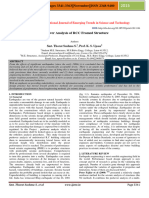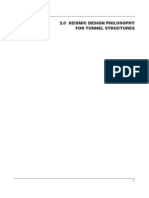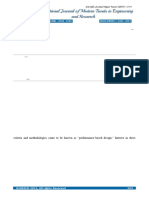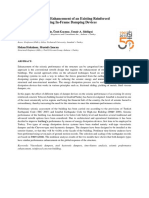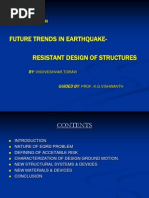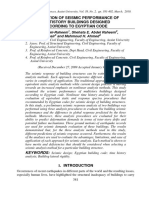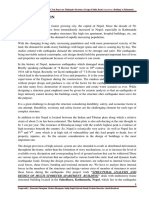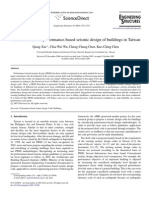Performance-Based Seismic Design Code For Buildings in Japan
Performance-Based Seismic Design Code For Buildings in Japan
Uploaded by
Maria Elena Sulca QuispeCopyright:
Available Formats
Performance-Based Seismic Design Code For Buildings in Japan
Performance-Based Seismic Design Code For Buildings in Japan
Uploaded by
Maria Elena Sulca QuispeOriginal Title
Copyright
Available Formats
Share this document
Did you find this document useful?
Is this content inappropriate?
Copyright:
Available Formats
Performance-Based Seismic Design Code For Buildings in Japan
Performance-Based Seismic Design Code For Buildings in Japan
Uploaded by
Maria Elena Sulca QuispeCopyright:
Available Formats
Midorikawa, Earthquake Engineering and Engineering Seismology 15
Volume 4, Number 1, September 2003, pp. 1525
Okawa, Iiba, Teshigawara: Performance-Based Seismic Design Code for Buildings in Japan 15
Performance-Based Seismic Design Code for
Buildings in Japan
Mistumasa Midorikawa
1)
Izuru Okawa
1)
Masanori Iiba
1)
Masaomi Teshigawara
1)
1) Building Research Institute, 1 Tachihara, Tsukuba, Ibaraki, 305-0802, Japan.
ABSTRACT
The seismic design code of buildings in Japan was revised in June 2000 to implement a
performance-based structural engineering framework. The code provides two
performance objectives: life safety and damage limitation of a building at two
corresponding levels of earthquake motions. The design earthquake motions are defined
in terms of the acceleration response spectra specified at the engineering bedrock in order
to take into consideration the soil conditions and soil-structure interaction effects as
accurately as possible. The seismic performance shall be verified by comparing the
predicted response values with the buildings estimated limit values. The verification
procedures of seismic performance in the new code are in essence a blend of the
equivalent single-degree-of-freedom modeling of a building and the site-dependent
response spectrum concepts, which make possible the prediction of the maximum
structural response against earthquake motions without using time history analysis.
INTRODUCTION
The 1995 Hyogoken-nanbu Earthquake caused
much loss of human lives and severe damage or
collapse of buildings [1]. Scientists and
engineers learned many lessons regarding
earthquake preparedness, disaster response,
seismic design, upgrading of existing buildings
and introduction of new technologies, which
assure high safety levels of buildings during
destructive earthquakes. As a result, the need for
a new generation of seismic design was
recognized and this recognition led to the
development of performance-based engineering
[2], whose framework explicitly addresses life-
safety, reparability and functionality issues.
The seismic provisions of the building code of
Japan were significantly revised in 2000 from an
existing prescriptive format into a performance-
based framework in order to expand design
alternatives. In particular, these revisions
allowed for the application of newly developed
materials, structural elements, structural systems
and construction. They are further expected to
encourage structural engineers to develop and
apply new construction technology. In the
revised code, the precise definitions for structural
performance requirements and verification
procedures are specified on the basis of clear
response and limit values. Assuming that
material properties are well defined and the
behavior of a building structure is properly
predicted, the code should be applicable to any
16 Earthquake Engineering and Engineering Seismology,
Vol. 4, No. 1
kind of material and any type of building
including seismic isolation systems.
This paper presents the concept and
framework of the new verification procedures of
seismic structural performance against major
earthquake motions in the performance-based
building code of Japan [3~6]. The verification
procedure for developing the seismic design
spectra includes (1) the basic design spectra
defined at the engineering bedrock, and (2) the
evaluation of site response from geotechnical data
of surface soil layers. The verification
procedures apply the equivalent linearization
technique using an equivalent single-degree-
of-freedom (ESDOF) system and the response
spectrum analysis, while the previous procedures
are based on the estimation of the ultimate
capacity for lateral loads of a building.
SEISMIC PERFORMANCE
REQUIREMENTS
The new procedures deal with the evaluation
and verification of structural performance at a set
of limit states under dead and live loads, snow
loads, and wind and earthquake forces. Two
limit states should be considered for building
structures to protect the life and property of the
occupants against earthquake motions; life safety
and damage limitation. To satisfy the life safety
limit state, the engineer should design the building
such that neither the entire building nor an
individulal story collapses. The damage limit
state aims to prevent and control damage to the
building, though some permanent deformation to
energy dissipating devices is acceptable. Even if
some damage occurs, the building must still
satisfy the life-safety limit state during a
subsequent earthquake.
Two sets of earthquake motions; maximum
earthquake motions and once-in-a-lifetime
earthquake motions are considered, each having
different probability of occurrence. The effects
of the design earthquake motions were maintained
at the same levels as the design seismic forces in
the previous code.
The level of maximum earthquake motions to
be considered corresponds to the category of
requirement for life safety and is assumed to
produce the maximum possible effects on the
structural safety of a building. The possible
level of a maximum earthquake is determined on
the basis of historical earthquake data, past
recorded strong motions, seismic and geologic
tectonics, active faults and other factors. This
earthquake motion level corresponds
approximately to that of the highest earthquake
forces used in the conventional seismic design
practice, representing the horizontal earthquake
forces induced in buildings in case of major
seismic events.
The level of once-in-a-lifetime events
corresponds with the category of requirement for
damage limitation of a building and is assumed to
be experienced at least once during the lifetime of
the building. A return period interval of 20 ~ 50
years is expected to cover these events. This
earthquake motion level corresponds
approximately to the middle level earthquake
forces used in the conventional seismic design
practice, representing the horizontal earthquake
forces induced in buildings in case of moderate
earthquakes.
DESIGN EARTHQUAKE MOTIONS
The design seismic forces in the previous code
were specified in terms of story shear forces as a
function of building period and soil conditions
without the apparent definition of earthquake
ground motions. Therefore, the previous design
seismic forces were easily applied to the seismic
design. However, they become inconsistent.
The estimated earthquake ground motions were not
equal among the different soil conditions, since the
previous design seismic forces were specified as
the response values of representative buildings. It
is also difficult to apply the design seismic forces to
new structural systems and construction techniques,
such as seismic isolation and structural-control
buildings, and to take into account the seismic
behavior of surface soil deposits. Considering this
inconsistency, it was concluded that the seismic
design should start with defining the input
Midorikawa, Okawa, Iiba, Teshigawara: Performance-Based Seismic Design Code for Buildings in Japan 17
earthquake ground motions. This methodology
coincides with the performance-based structural
engineering framework, which aspires toward
flexible design. Consequently, new seismic
design procedures including the design earthquake
response spectrum [3~6] have been introduced to
replace previous procedures.
Design Response Spectrum at Engineering
Bedrock
The earthquake ground motion used for the
seismic design at the life-safety limit state is the
site-specific motion of an extremely rare
earthquake, which is expected to occur once in
approximately 500 years. The engineering
bedrock is assumed to be a soil layer whose shear
wave velocity is equal to or more than about
400m/s. The basic design earthquake acceleration
response spectrum, S
0
, of the seismic ground
motion at the exposed (outcrop) engineering
bedrock is shown in Fig. 1 and given in Eq. (1).
) 30 2 . 3 ( ) (
0
T T S + = for 16 . 0 < T
0 . 8 ) (
0
= T S for 64 . 0 16 . 0 < T
T
T S
12 . 5
) (
0
= for (1) T 64 . 0
where,
S
0
: basic design acceleration response spectrum at
the exposed (outcrop) engineering bedrock
(m/s
2
), and,
T : natural period (s).
Fig. 1 Basic design earthquake acceleration
response spectra at exposed engineering
bedrock
The level of the earthquake ground motion
used for the seismic design at the damage-
limitation limit state should be reduced to a fifth
of that for life safety. These response spectra at
the engineering bedrock are applied in the design
of all buildings, including conventionally
designed buildings and seismically isolated
buildings.
Design Response Spectrum at Ground
Surface
Multiplying the response spectrum at the
engineering bedrock by the surface soil layer
amplification factor, G
s
, as shown in Fig. 2, the
design earthquake response spectrum at the
ground surface, S
a
, is obtained as shown in Fig. 3
and expressed by Eq. (2).
) ( ) ( ) (
0
T S Z T G T S
s a
= (2)
where,
S
a
: design acceleration response spectrum at
ground surface (m/s
2
),
G
s
: surface soil layer amplification factor,
Z : seismic zone factor of 0.7 to 1.0, and,
T : natural period (s).
Fig. 2 Amplification factor of surface soil layers
Fig. 3 Design earthquake acceleration response
spectrum at ground surface
18 Earthquake Engineering and Engineering Seismology,
Vol. 4, No. 1
The calculation procedures of the amplification
factor, G
s
, are given by the accurate or simplified
procedures [6,7]. G
s
to be determined here is the
ratio of response spectra. Practically, the accurate
procedures considering the strain-dependent
properties of soils are available for most of soil
conditions. G
s
is calculated based on the
strain-dependent shear stiffness and damping ratio
of soil [8~10]. G
s
is given by Eq. (3):
2
2
8 . 0 T
T
G G
S S
= for
2
8 . 0 T T
) 8 . 0 (
) ( 8 . 0
2
2 1
2 1
2
T T
T T
G G
G G
S S
S S
+ =
2
8 . 0 T <
for
1
2 . 1 T T
1 S S
G G = for
1 1
2 . 1 8 . 0 T T T <
|
|
.
|
\
|
+ =
1
1
1
1
2 . 1
1 1
1 . 0
2 . 1
1
0 . 1
T T
T
G
G G
S
S S
for T T <
1
2 . 1
(3)
where,
G
s
: surface-soil-layer amplification factor,
G
s1
: G
s
value at the period of T
1
,
G
s2
: G
s
value at the period of T
2
,
T : natural period (s),
T
1
: predominant period of surface soil layers
for the first mode (s), and,
T
2
: predominant period of surface soil layers
for the second mode (s).
Minimum value of G
s
: 1.5 for T 1.2T
1
and 1.35
for 1.2T
1
< T at the damage-limitation limit state,
and 1.2 for T 1.2T
1
and 1.0 for 1.2T
1
< T at the
life-safety limit state.
The factors of 0.8 and 1.2 in the period
classification such as 0.8T
1
, 0.8T
2
and 1.2T
1
in Eq.
(3) are introduced to consider the uncertainties
included in the soil properties and the simplified
calculation.
Amplification Factor for Surface Soil Layers
The calculation procedures of the surface soil
layer amplification factor, G
s
, in surface soil layers
according to the provision [7] are illustrated in Fig.
4. The iteration is required in the calculation
procedures because of soil nonlinearity.
(a) Properties of soil layers (b) Equivalent uniform
surface soil layer
(c) Amplification factor of equivalent surface soil layer
(d) Design acceleration response spectrum at ground surface
Fig. 4 Amplification factor of surface soil layers
Midorikawa, Okawa, Iiba, Teshigawara: Performance-Based Seismic Design Code for Buildings in Japan 19
The amplification of ground motion by surface
soil layers is estimated using the geotechnical data
at the site, the equivalent single soil layer modeled
from surface soil layers, and the equivalent
linearization technique. The nonlinear amplifi-
cation of ground motion by a uniform soil layer
above the engineering bedrock is evaluated by
applying the one-dimensional wave propagation
theory.
The surface soil layers are reduced to an
equivalent single soil layer. Consequently, the
soil layers including the engineering bedrock are
reduced to the equivalent two-soil-layer model.
The characteristic values of the equivalent surface
soil layer are expressed by Eqs. (4) to (7):
H
d V
V
i si
se
= (4)
V
T =
3
T =
H
d
i i
e
= (5)
+
=
h
G
1
=
si
si i
se
W
W h
h (6)
+
=
h
G
4
=
i
d H (7)
=
where,
V
se
: equivalent shear wave velocity of surface
soil layers (m/s),
e
: equivalent mass density of surface soil
layers (t/m
3
),
h
se
: equivalent damping ratio of surface soil
layers,
H : total thickness of surface soil layers (m),
V
si
: shear wave velocity of soil layer i (m/s),
d
i
: thickness of soil layer i (m),
i
: mass density of soil layer i (t/m
3
),
d
i
: thickness of soil layer i (m),
h
i
: viscous damping ratio of soil layer i, and,
W
si
: potential energy of soil layer i.
Equation (6) represents the averaged value of
the equivalent viscous damping ratio of the
equivalent surface soil layer. The value of h
i
in
Eq. (6) is estimated from geotechnical data at the
site or the relationships of viscous damping ratio
and shear strain of soils given in the provision [7].
Finally, the viscous damping ratio, h
seq
, of the
equivalent surface soil layer is estimated by Eq. (8)
at the final step of iteration in the calculation,
considering the scattering of geotechnical data for
estimating damping ratios.
=
i s
i s i
seq
W
W h
h 8 . 0 (8)
The first and second predominant periods, T
1
and T
2
, and amplification factors, G
s1
and G
s2
, of
the equivalent surface soil layer are obtained by
Eqs. (9) to (12):
se
H 4
1
,
1
2
T
(9)
seq
s
57 .
1
1
(10)
seq
s
71 .
1
2
(11)
sb b
se e
V
V
(12)
where,
: wave impedance ratio,
b
: mass density of engineering bedrock (t/m
3
),
and,
V
sb
: shear velocity of engineering bedrock (m/s).
Minimum value of G
s1
: 1.5 at the damage-
limitation limit state and 1.2 at the life-safety limit
state.
Equations (10) and (11) are obtained from
previous studies [11,12].
VERIFICATION OF SEISMIC
PERFORMANCE
Verification Procedures for Major
Earthquake Motions
The new verification procedures involve the
application of the equivalent linearization
20 Earthquake Engineering and Engineering Seismology,
Vol. 4, No. 1
technique using an equivalent single-degree-
of-freedom (ESDOF) system and the response
spectrum analysis, while the previous procedures
were based on the estimation of the ultimate
capacity for lateral loads of a building. A variety
of linearization techniques have already been
studied [e.g., 13]. Several applications of
linearization techniques have also been published
[14~17].
Various response and limit values are
considered for use in the performance verification
procedures in accordance with each of the
requirements prescribed for building structures.
The principle of the verification procedures is that
the predicted response values caused by
earthquake motions should not exceed the
estimated limit values. In the case of a major
earthquake, the maximum strength and
displacement response values should be smaller
than the ultimate capacity for strength and
displacement.
The focus is hereafter placed on the
verification procedures for major earthquakes.
The analytical method used for predicting the
structural response applies the equivalent
linearization technique using an ESDOF system
and the response spectrum analysis. A flow of
the procedures is illustrated in Fig. 5.
According to the verification procedures, the
steps to be followed are:
(1) Confirm the scope of application of the
procedures and the mechanical properties of
materials and/or members to be used in a
building.
(2) Determine the design response spectra used in
the procedures.
(a) For a given basic design spectrum at the
engineering bedrock, draw up the
acceleration, S
a
, and displacement response
spectra, S
d
, at ground surface for the
different damping levels.
(b) In the estimation of the free-field site-
dependent acceleration and displacement
response, consider the strain-dependent soil
deposit characteristics.
(c) If needed, present the relation of S
a
-S
d
for
the different damping levels (see Fig. 5(c)).
(3) Determine the hysteretic characteristics,
equivalent stiffness and equivalent damping
ratio of the building.
(a) Model the building as an ESDOF system
and establish its force-displacement
relationship (see Fig. 5(a)).
(b) Determine the design limit strength and
displacement of the building corresponding
to the ESDOF system.
(c) The soil-structure interaction effects
should be considered if necessary.
(d) If needed, determine the equivalent stiffness
in accordance with the limit values.
(e) Determine the equivalent damping ratio
on the basis of the viscous damping ratio,
hysteretic dissipation energy and elastic
strain energy of the building (see Fig. 5(b)).
(f) If the torsional vibration effects are
predominant in the building, these effects
should be considered when establishing the
force-displacement relationship of the
ESDOF system.
(4) Examine the safety of the building. In this
final step, it is verified whether the response
values predicted on the basis of the response
spectra determined according to step 2 satisfy
the condition of being smaller than the limit
values estimated on the basis of step 3 (see Fig.
5(c)).
In order to determine the design limit strength
and displacement of the building, it is necessary to
assume a specific displaced mode for its inelastic
response (see Figure 5(a)). Basically, any
predominant or potential displaced mode should
be considered.
Estimation of Ultimate Deformation of a
Member
The seismic performance of a building is
evaluated at the two limit states under the two
levels of design earthquake motions.
The limit state of damage limitation is attained
when the working stress increases to the allowable
stress of materials in any member or when the
Midorikawa, Okawa, Iiba, Teshigawara: Performance-Based Seismic Design Code for Buildings in Japan 21
(a) Reduction of building to ESDOF system by pushover
analysis
(b) Equivalent damping ratio using hysteretic energy
dissipation
(c) Performance criteria using demand spectra and
force-displacement relationship of ESDOF system in
S
a
-S
d
relations
Fig. 5 Verification procedures for major
earthquake motions
story drift reaches 1/200 of the story height at any
story. The limit state of life safety is reached
when the building cannot sustain the gravity loads
at any story under additional lateral drift, that is, a
structural member has reached its ultimate
deformation capacity. The ultimate deformation
of a member should be estimated by Eq. (13).
x s b u
R R R R + + = (13)
where,
R
u
: ultimate deformation of a member,
R
b
: flexural deformation of a member,
R
s
: shear deformation of a member, and,
R
x
: deformation resulting from the deformation in
the connection to adjacent members and
others.
The ultimate flexural deformation, R
b
, should be
calculated as follows:
|
.
|
\
|
+
=
a
l
l
a
R
p
p y u
y
b
2
1 ) (
3
(14)
where,
y
: curvature of a member when the allowable
stress is first reached in the member,
u
: curvature of a member at the maximum
resistance,
l
p
: length of plastic region, and,
a : shear span or a half of clear length of a
member.
Modeling of Multi-Degree-of-Freedom
System into ESDOF System
In estimating the seismic response of a multi-
story building structure, the building is modeled as
an ESDOF system as shown in Fig. 5. This
modeling is based on the result of the nonlinear
pushover analysis under the horizontal forces at
each floor level, of which the distribution along the
height should be proportional to the first mode
shape of vibration or the A
i
distribution prescribed
in the provision [8]. The modeling is discussed in
detail elsewhere [18].
The deflected shape resulting from the
pushover analysis is assumed to represent the first
mode shape of vibration. As the deflected shape
does not change very much with the distribution of
horizontal forces along the height, the fixed force
distribution is used during the pushover analysis.
The modal analysis is applied to relate the
seismic response of the multi-degree-of-freedom
and ESDOF systems. For spectral response
acceleration,
1
S
a
, and displacement,
1
S
d
, at the
22 Earthquake Engineering and Engineering Seismology,
Vol. 4, No. 1
first-mode period and damping, the first-mode
inertia force vector,
1
{f}, and displacement vector,
1
{}, are expressed in the following:
a
S u m f
1 1
} { ] [ } {
1 1
= (15)
d
S u
1 1 1 1
} { } { = (16)
where,
1
S
a
: spectral response acceleration for the first
mode,
1
S
d
: spectral response displacement for the first
mode,
1
{f} : inertia force vector for the first mode,
1
{} : displacement vector for the first mode,
1
: modal participation factor for the first
mode,
1
{u} : mode shape vector for the first mode
(normalized to the roof displacement,
1
1
S
d
), and,
[m] : lumped floor mass matrix.
The modal participation factor is expressed as
follows:
} { ] [ } {
} 1 { ] [ } {
1 1
1
1
u m u
m u
T
T
= (17)
where,
{1}: unit vector.
The force-displacement relationship of the
ESDOF system is given by Eqs. (18) and (19),
when the force corresponds to the base shear,
1
Q
b
,
and its displacement,
1
, corresponds to the
displacement at the equivalent height, h
e
, where
the modal participation function,
1
1
{u}, is equal
to unity.
1
Q
a e a
T T
b
S M S u m f
1 1 1 1 1 1
} { ] [ } 1 { } { } 1 { = = = (18)
d
S
1 1
= (19)
where,
1
Q
b
: base shear corresponding to the first mode,
1
: displacement at the equivalent height
corresponding to the first mode, and,
1
M
e
: effective modal mass corresponding to the
first mode given as follows:
} { ] [ } 1 {
1 1 1
u m M
T
e
= (20)
According to the provision [7], the effective mass
should not be less than 0.75 times the total mass
of the building.
Force-Displacement Curve in S
a
-S
d
Relations
Assuming that the first-mode displacement
and inertia force vectors are equal to the floor
displacement and external force distributions,
respectively obtained from the pushover analysis,
the force-displacement relationship of an ESDOF
system is expressed in spectral acceleration and
displacement (S
a
-S
d
) relations as follows:
b
T
T
e
b
a
Q
m
m
M
Q
S
1
2
1
1 1
1
1
1
}) 1 { ] [ } { (
} { ] [ } {
= = (21)
a
T
T
e
a
d
S
f
m S
S
1
1 1
1 1
2
1
1
1 1
} { } {
} { ] [ } {
= = (22)
where,
1
e
: effective circular frequency for the
first mode.
The effective first-mode circular frequency of
the building at each loading step is approximately
estimated by Eq. (23).
} { ] [ } {
} { } {
} { ] [ } 1 {
} { ] [ } {
1 1
1 1
1 1
1 1 1 1
1
1
1
= =
m
f
u m
u k u
M
K
T
T
T
T
e
e
e
(23)
where,
1
K
e
: effective modal stiffness corresponding to the
first mode, and,
[k]: stiffness matrix of the building.
Consequently, using Eqs. (21) and (22), the
external forces and displacements at each floor
level, and the base shear at each loading step
obtained from the nonlinear pushover analysis, the
force-displacement relationship of the ESDOF
system in S
a
-S
d
relations may be plotted as
illustrated in Fig. 5(c). This relation is
Midorikawa, Okawa, Iiba, Teshigawara: Performance-Based Seismic Design Code for Buildings in Japan 23
sometimes called the capacity curve of the
building.
Estimation of Equivalent Damping Ratio
The equivalent damping ratio is defined by the
viscous damping, hysteretic dissipation energy,
elastic strain energy of a building and the
radiation damping effects of the ground.
The equivalent damping ratio for the first
mode is prescribed to be 0.05 at the damage-
limitation limit state because the behavior of a
building is basically elastic.
The equivalent viscous damping ratio at the
life-safety limit state is defined by equating the
energy dissipated by hysteretic behavior of a
nonlinear system and the energy dissipated by
viscous damping under stationary vibration in
resonance. The equivalent damping ratio of an
ESDOF system,
st
h
eq
, is defined as follows (see
Fig. 5(b)).
W
W
h
eq st
=
4
1
(24)
| |
where,
st
h
eq
: equivalent damping ratio of an ESDOF
system under resonant stationary vibration,
W : dissipation energy of an ESDOF system,
and,
W : potential energy of an ESDOF system
(
1
Q
b
1
/2).
The dissipation energy of a stationary
hysteretic loop at the assumed maximum response
of a building is either estimated by calculating the
area of the supposed cyclic loop of the building in
the nonlinear pushover analysis, or determined
based on the equivalent damping ratio of each
structural element considered.
Equation (24) does not hold in the response
under nonstationary excitations such as
earthquake motions. The equivalent damping
ratio under stationary vibration must be reduced to
correlate the maximum response of an equivalent
linear system and a nonlinear system under
earthquake motions. According to the analytical
results [5], the equivalent damping ratio is
reduced to approximately 80 percent of that
calculated by Eq. (24).
The equivalent damping ratio, h
eq
, of an
ESDOF system should be in principle estimated
as the weighted average with respect to strain
energy of each member according to the provision
[7]:
05 . 0 + =
i m
i m eqi m
eq
W
W h
h (25)
where,
h
eq
: equivalent damping ratio of an ESDOF
system,
m
h
eqi
: equivalent damping ratio of member i ,
and,
m
W
i
: strain energy stored in member i at ultimate
deformation.
The equivalent damping ratio,
m
h
eqi
, of member i
is estimated as follows:
|
|
.
\
=
1
1
eqi m
h (26)
where,
: ductility factor of a member reached at the
ultimate state of a building.
The factor of is the reduction factor
considering the damping effect for the transitional
seismic response of the building [13]. It takes
the values of 0.25 for ductile members and 0.2 for
non-ductile ones. When all structural members
of a building structure have the same hysteretic
characteristics, the equivalent damping ratio of a
whole building can be estimated by Eq. (26).
Soil-Structure Interaction Effects
The effective period and equivalent damping
ratio should be modified by the following
equations taking into consideration the effects of
soil-structure interaction if necessary in case of
major earthquake motions. A sway-rocking
analytical model is assumed in the modeling of
soil-structure system.
24 Earthquake Engineering and Engineering Seismology,
Vol. 4, No. 1
2 2
1
|
|
.
|
\
|
+
|
|
.
|
\
|
+ =
e
ro
e
sw
T
T
T
T
r (27)
+
|
|
.
|
\
|
+
|
|
.
|
\
|
=
b
e
ro
ro
e
sw
sw eq
h
T
T
h
T
T
h
r
h
3 3
3
1
(28)
where,
r : period modification factor,
T
e
: effective period of a fixed-base super-
structure at ultimate state,
T
sw
: period of sway vibration at ultimate state,
T
ro
: period of rocking vibration at ultimate state,
h
sw
: damping ratio of sway vibration of surface
soil layers corresponding to shear strain level
considered, but the value is limited to 0.3,
h
ro
: damping ratio of rocking vibration or surface
soil layers corresponding to shear strain level
considered, but the value is limited to 0.15,
and,
h
b
: equivalent damping ratio of a super-
structure at ultimate state.
Demand S
a
-S
d
Spectrum and Response
Spectrum Reduction Factor
Response spectral displacement, S
d
(T), is
estimated from the linearly elastic design
acceleration response spectrum, S
a
(T), at the free
surface by Eq. (29). The demand S
a
-S
d
spectra
for different damping ratios are constructed using
Eq. (29) as illustrated in Fig. 5(c).
) (
2
) (
2
T S
T
T S
a d |
.
|
\
|
= (29)
The demand S
a
-S
d
spectra are prepared for the
damping ratio of 0.05 up to the yield displacement,
and for the estimated equivalent damping ratio up
to the ultimate displacement. Beyond the yield
displacement, the response spectral acceleration
and displacement are reduced by the following
factor:
eq
h
h
F
10 1
5 . 1
+
= (30)
where, F
h
: response spectrum reduction factor.
Seismic Performance Criteria
The seismic performance of a building under
the design earthquake motion is examined by
comparing the force-displacement relationship of
the building and the demand spectrum of the
design earthquake motion in S
a
-S
d
relations. The
intersection of the force-displacement relationship
and the demand spectrum for the appropriate
equivalent damping ratio represents the maximum
response under the design earthquake motion as
shown in Fig. 5(c).
In the provision [7], spectral acceleration of
a building, defined by Eq. (21), at a limit state
should be equal to or higher than the
corresponding acceleration of the demand
spectrum using the effective period, corres-
ponding to Eq. (23), and equivalent damping ratio,
expressed by Eqs. (25) or (26), at the limit state.
CONCLUSIONS
This paper presents the seismic design code of
buildings in Japan revised in June 2000 toward a
performance-based structural engineering
framework. The code provides two performance
objectives: life safety and damage limitation of a
building at corresponding levels of earthquake
motions. The design earthquake motions are
defined as the acceleration response spectra
specified at the engineering bedrock in order to
take into consideration the soil conditions and
soil-structure interaction effects as accurately as
possible. Design earthquakes with return periods
of approximately 500 years and 50 years are used
to evaluate the seismic performance at the life-
safety and damage-limitation levels, respectively.
The seismic performance shall be verified by
comparing the predicted response values with the
estimated limit values of both the overall building
and structural components.
The verification procedures for seismic
performance against the design earthquake
motions in the new code are in essence a blend of
the ESDOF modeling of a building and the site-
dependent response spectrum concepts, and the
application of a nonlinear pushover analysis and
the modal analysis. The new procedures make
possible the prediction of the maximum structural
response against earthquake motions without
using time history analysis.
Midorikawa, Okawa, Iiba, Teshigawara: Performance-Based Seismic Design Code for Buildings in Japan 25
ACKNOWLEDGMENTS
Preparation of this paper was stimulated by
the authors participation as members of the Task
Committee to Draft Performance-based Building
Provisions of the Building Research Institute
where they have shared their opinions with other
committee members. The authors would like to
express their gratitude towards all of them.
REFERENCES
1. Building Research Institute (1996). A Survey
Report for Building Damages due to the 1995
Hyogoken-Nanbu Earthquake, 222p.
2. Yamanouchi, H. and et al. (2000). Performance-
based Engineering for Structural Design of
Buildings, BRI Research Paper, No. 146,
Building Research Institute, 135p.
3. Hiraishi, H., Midorikawa, M., Teshigawara, M.,
Gojo, W. and Okawa, I. (2000). Development
of performance-based building code of Japan-
framework of seismic and structural provisions,
Proceedings, 12th World Conference on
Earthquake Engineering, Auckland, New
Zealand, Paper ID 2293.
4. Midorikawa, M., Hiraishi, H., Okawa, I., Iiba,
M., Teshigawara, M., Isoda, H., (2000).
Development of seismic performance
evaluation procedures in Building Code of
Japan, Proceedings, 12th World Conference on
Earthquake Engineering, Auckland, New
Zealand, Paper ID 2215.
5. Hiraishi, H. and et al. (1999). Seismic
evaluation of buildings by acceleration spectrum
at engineering bedrock (Part 1-Part 13),
Structures II, Summaries of Technical Papers of
Annual Meeting, AIJ, pp. 1125-1150 (in
Japanese).
6. Miura, K., Koyamada, K. and Iiba, M. (2000).
Response spectrum method for evaluating
nonlinear amplification of surface strata,
Proceedings, 12th World Conference on
Earthquake Engineering, Auckland, New
Zealand, Paper ID 509.
7. Ministry of Land, Infrastructure and Transport
(2000). Notification No.1457-2000, Technical
Standard for Structural Calculation of Response
and Limit Strength of Buildings, (in Japanese).
8. Ministry of Land, Infrastructure and Transport
(1980). Notification No.1793-1980, Technical
Standard for Calculation of Seismic Story Shear
Distribution Factor along the Height of a
Building Structure, etc., (in Japanese).
9. Ohsaki, Y., Hara, A. and Kiyota, Y. (1978).
Stress-strain model of soils for seismic
analysis, Proceedings, 5th Japanese Earthquake
Engineering Symposium, pp. 679704 (in
Japanese).
10. Schnabel, P.B., Lysmer, J. and Seed, H.B.
(1972). SHAKE: A computer program for
earthquake response analysis of horizontally
layered sites, Report No. UCB/EERC-72/12,
Univ. of California, Berkeley, Calif.
11. Roesset, J.M. and Whitman, R.V. (1969).
Theoretical Background for Amplification
Studies, Research Report R69-15, Soils
Publication No.231, Dept. of Civil Engineering,
Massachusetts Institute of Technology.
12. Ohsaki, Y. (1982). Dynamic Characteristics and
One-Dimensional Linear Amplification Theories
of Soil Deposits, Research Report 82-01, Dept. of
Architecture, Tokyo Univ.
13. Shibata, A. and Sozen, M.A. (1976). Substitute
structure method for seismic design in R/C,
Journal of the Structural Division, ASCE, Vol.
102, No. ST1, pp. 118.
14. AIJ (1989). Recommendation for the Design of
Base Isolated Buildings, Architectural Institute of
Japan (in Japanese).
15. AIJ (1992). Seismic Loading Strong Motion
Prediction and Building Response, Architectural
Institute of Japan, Tokyo (in Japanese).
16. Freeman, S.A. (1978). Prediction of response of
concrete buildings to severe earthquake motion,
Douglas McHenry International Symposium on
Concrete and Concrete Structures, SP-55, ACI,
pp. 589-605.
17. ATC-40 (1996). Seismic Evaluation and Retrofit
of Concrete Buildings, Report No. SSC 96-01,
Applied Technology Council.
18. Kuramoto, H., Teshigawara, M., Okuzono, T.,
Koshika, N., Takayama, M. and Hori, T. (2000).
Predicting the earthquake response of buildings
using equivalent single degree of freedom
system, Proceedings, 12th World Conference on
Earthquake Engineering, Paper ID 1093.
You might also like
- 14 05-01-0174 NZS1170.5 2004Document8 pages14 05-01-0174 NZS1170.5 2004Manuel PereiraNo ratings yet
- Reinforced Concrete Buildings: Behavior and DesignFrom EverandReinforced Concrete Buildings: Behavior and DesignRating: 5 out of 5 stars5/5 (1)
- New Seismic Design Provisions in JapanDocument19 pagesNew Seismic Design Provisions in JapanBrian Taylor100% (1)
- Fundamental Principles of Earthquake Resistance Calculation To Be Reflected in The Next Generation RegulationsDocument6 pagesFundamental Principles of Earthquake Resistance Calculation To Be Reflected in The Next Generation RegulationsBenmark JabayNo ratings yet
- Seismic Design Codes For Buildings in Japan: Hiroshi KuramotoDocument16 pagesSeismic Design Codes For Buildings in Japan: Hiroshi KuramotoMatias jamesNo ratings yet
- Analysis of Seismic Retrofitting on Rc Building IJERTCONV7IS12037 (1)Document6 pagesAnalysis of Seismic Retrofitting on Rc Building IJERTCONV7IS12037 (1)soumyasonawaneNo ratings yet
- A New Round of Updation of Seismic Design Code of China: Yayong WangDocument6 pagesA New Round of Updation of Seismic Design Code of China: Yayong Wangpescanova3No ratings yet
- Seismic Design of StructuresDocument8 pagesSeismic Design of StructuresMuyiwa AyodejiNo ratings yet
- Pushover Analysis of RCC Framed StructurDocument23 pagesPushover Analysis of RCC Framed StructurGleizel AutorNo ratings yet
- Seismic Building Codes in JapanDocument2 pagesSeismic Building Codes in Japanpushpak2312No ratings yet
- Tunnel Structures Seismic DesignDocument12 pagesTunnel Structures Seismic DesignIbis TelloNo ratings yet
- Research ArticleDocument9 pagesResearch Articlerithy khouyNo ratings yet
- M.E. Thesis Push Over AnalysisDocument45 pagesM.E. Thesis Push Over AnalysisAnonymous nwByj9L100% (1)
- The Effect of Wind Loads On The Seismic Performance of Tall BuildingsDocument25 pagesThe Effect of Wind Loads On The Seismic Performance of Tall BuildingsjcvalenciaNo ratings yet
- (1992) Dynamic Response of High-Rise Buildings To Stochastic Wind LoadsDocument9 pages(1992) Dynamic Response of High-Rise Buildings To Stochastic Wind Loadsryan rakhmat setiadiNo ratings yet
- New Seismic Design Provisions in Japan Shunsuke OTANI: Email. Otani@sake.t.u-Tokyo - Ac.jpDocument8 pagesNew Seismic Design Provisions in Japan Shunsuke OTANI: Email. Otani@sake.t.u-Tokyo - Ac.jpAnup Kumar HalderNo ratings yet
- IRS BR CS With CommentsDocument19 pagesIRS BR CS With CommentsSiddhartha SinghNo ratings yet
- Chapter 1: Introduction: Department of Civil Engineering STJIT RanebennurDocument5 pagesChapter 1: Introduction: Department of Civil Engineering STJIT RanebennurAdithya H.BNo ratings yet
- Performance Based Seismic Design of Structures A Review 119dt9a0v4Document9 pagesPerformance Based Seismic Design of Structures A Review 119dt9a0v4Md Rafiul IslamNo ratings yet
- Dynamic Analysis of Multistoried Regular BuildingDocument6 pagesDynamic Analysis of Multistoried Regular BuildingapirakqNo ratings yet
- Seismic Design Code For Buildings in TaiwanDocument51 pagesSeismic Design Code For Buildings in TaiwanReyyan KhalidNo ratings yet
- 1 s2.0 S2352710223002899 MainDocument21 pages1 s2.0 S2352710223002899 MainAsfand JanabNo ratings yet
- Study On Performance-Based Seismic Vulnerability of Reinforced Concrete Frame StructuresDocument9 pagesStudy On Performance-Based Seismic Vulnerability of Reinforced Concrete Frame StructuresAli NajiNo ratings yet
- Mitigation On PoundingDocument12 pagesMitigation On PoundingNoman KhanNo ratings yet
- Structural Concept DesignDocument8 pagesStructural Concept DesignaahtagoNo ratings yet
- Seismic Performance Enhancement of An Existing Reinforced Concrete Building Using In-Frame Damping DevicesDocument14 pagesSeismic Performance Enhancement of An Existing Reinforced Concrete Building Using In-Frame Damping DevicesAKSNo ratings yet
- PAPER 3 - Research and Development of PBSDDocument7 pagesPAPER 3 - Research and Development of PBSDSantiago PinzónNo ratings yet
- IZIIS50 Prota PDFDocument14 pagesIZIIS50 Prota PDFAKSNo ratings yet
- Seismic Performance Analysis of RCC Multi-Storied Buildings With Plan IrregularityDocument6 pagesSeismic Performance Analysis of RCC Multi-Storied Buildings With Plan IrregularityImdad Ullah KhanNo ratings yet
- RCsolver Theory Manual ENGDocument41 pagesRCsolver Theory Manual ENGtrannguyenvietNo ratings yet
- Ijri Cce 01 003Document12 pagesIjri Cce 01 003ijripublishersNo ratings yet
- 1 Ijcseierdaug20181Document10 pages1 Ijcseierdaug20181TJPRC PublicationsNo ratings yet
- Effect of Earthquake and Wind Load On Residential by Using EtabsDocument61 pagesEffect of Earthquake and Wind Load On Residential by Using EtabsManojkumarNo ratings yet
- Seismc NPPDocument22 pagesSeismc NPPsumit_fm77No ratings yet
- Abhimod EQ Module 3 Ref Notes PDFDocument21 pagesAbhimod EQ Module 3 Ref Notes PDFathiraprNo ratings yet
- Detection of Beam End Fractures in Steel Members Based On - 2021 - EngineeringDocument10 pagesDetection of Beam End Fractures in Steel Members Based On - 2021 - EngineeringTONY VILCHEZ YARIHUAMANNo ratings yet
- Future Trends in Earthquake-Resistant Design of Structures: Seminar OnDocument24 pagesFuture Trends in Earthquake-Resistant Design of Structures: Seminar OnManther GenxNo ratings yet
- Literature ReviewwwDocument22 pagesLiterature ReviewwwShayan AbagnaleNo ratings yet
- Evaluation of Seismic Performance of Multistory Buildings Designed According To Egyptian CodeDocument22 pagesEvaluation of Seismic Performance of Multistory Buildings Designed According To Egyptian CodeWeleed MoustafaNo ratings yet
- RetrofittingDocument25 pagesRetrofittingYashu YashuNo ratings yet
- Foundation DesignDocument7 pagesFoundation DesignPrasad GNNo ratings yet
- (2019) Verdugo, R. Seismic Site ClassificationDocument13 pages(2019) Verdugo, R. Seismic Site ClassificationJavier MtNo ratings yet
- 2first Chapter To Four12Document95 pages2first Chapter To Four12buntyNo ratings yet
- Draft Code of PFB Seismic DesignDocument13 pagesDraft Code of PFB Seismic Designrabindora6588No ratings yet
- 1 s2.0 S0141029618312914 MainDocument16 pages1 s2.0 S0141029618312914 MainMd Rajibul IslamNo ratings yet
- Evaluation of The Seismic Behavior Factor and Inter-Story Drift Index For Confined Masonry BuildingsDocument11 pagesEvaluation of The Seismic Behavior Factor and Inter-Story Drift Index For Confined Masonry BuildingsangelomarinilliNo ratings yet
- Seismic DesignDocument21 pagesSeismic DesignOscarKonzultNo ratings yet
- 1.1. General: Seismic Performance of Steel On Different Span ArrangementsDocument7 pages1.1. General: Seismic Performance of Steel On Different Span ArrangementsChetan PatilNo ratings yet
- Analysis and Design of Hospital Building C+G+5 Using EtabsDocument4 pagesAnalysis and Design of Hospital Building C+G+5 Using EtabsSarah FatimaNo ratings yet
- GutiérrezDocument18 pagesGutiérrezalexanderhcNo ratings yet
- Seismic Life-Cycle Functional Recovery Analysis of Corroded Reinforced Concrete BuildingsDocument11 pagesSeismic Life-Cycle Functional Recovery Analysis of Corroded Reinforced Concrete BuildingsThea Sofia Newton-JohnNo ratings yet
- Seismic Vulnerability Assessment of Reinforced ConcreteDocument15 pagesSeismic Vulnerability Assessment of Reinforced ConcreteLawend KoramarkiNo ratings yet
- Comparison On The Effect of Earthquake and Wind Loads On The Performance of Reinforced Concrete BuildingsDocument8 pagesComparison On The Effect of Earthquake and Wind Loads On The Performance of Reinforced Concrete Buildings98675No ratings yet
- Ijret - Comparison of Percentage Steel and Concrete Quantities of A R.C Building in Different Seismic ZonesDocument11 pagesIjret - Comparison of Percentage Steel and Concrete Quantities of A R.C Building in Different Seismic ZonesInternational Journal of Research in Engineering and TechnologyNo ratings yet
- Assessing Seismic Resilience in Suspension Bridges: Nonlinear Modeling and Strategies for Mitigating FailuresFrom EverandAssessing Seismic Resilience in Suspension Bridges: Nonlinear Modeling and Strategies for Mitigating FailuresNo ratings yet
- Unshakeable: Engineering Buildings to Withstand Mother NatureFrom EverandUnshakeable: Engineering Buildings to Withstand Mother NatureNo ratings yet
- Introduction to Design of Building StructuresFrom EverandIntroduction to Design of Building StructuresRating: 4 out of 5 stars4/5 (22)








